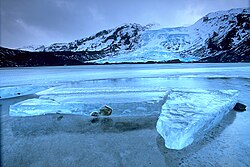
This is a list of glaciers in Europe.

This is a list of glaciers in Europe.
The Italian glaciological committee reports more than 700 glaciers in Italy. [2]
Glaciers in the Sierra Nevada and the Picos de Europa melted by the end of the 19th century. In 2006, ten small glaciers and six glaciers-glacierets remain in the Spanish Pyrenees. [7] [8] The largest are on:
The pyrenees have a lot of small glaciers that have stopped moving or haven't been studied since becoming very small. For example, in the Monte Perdido masif there were many more glaciers, like the Grieta, the La cascade, the Marboré, the Paillas (two glaciers), and the Astazou. As of today these glaciers still have glacier snow and some, like the Astazou or the Paillas, that are the biggest, could be considered glaciers, but they haven't been studied in recent years.
Sweden has a total of around 300 glaciers. The largest is Stuorrajekna in Sulitelma with an area of 13 km2.
 |  |  |